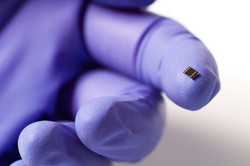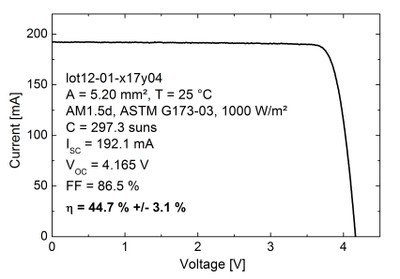
A new world record for converting sunlight into electricity has been set, as announced by the German Fraunhofer Institute for Solar Energy Systems, Soitec, CEA-Lets, and the Helmholtz Center in Berlin. The researchers concluded that by developing an advanced structure with four solar subcells, an efficiency of 44.7% was noted. This breakthrough is a major innovation in the furtherance of solar electricity efficiency by 50%, while helping reduce overall cost. After three investigative years of intense research and diligence, 44.7% of the spectrum’s solar power efficiency is converted from infrared into electrical energy. Specialists observed that this 44.7% increase was gathered from the power of 297 suns.
This study’s prior advancement was announced in May 2013, when the German-French team of Fraunhofer ISE, Soitec, CEA-Leti, and the Helmholtz Center Berlin observed a level of 43.6% efficiency.
The technology of concentrator photovoltaics (CPV), used in solar cell experiments and operations, doubles the efficiency of a PV power plant in areas that have much sun exposure. The method of III-V multijunction solar cells that is used to convert sunlight to electricity originated from outer-space technology; it has since been proven as the most efficient scientific method for solar cell advancements in the field. The multijunction solar cell is composed of several cells, each made from different III-V semiconductor materials, which are then piled together, one by one, to create a layered stack. Wavelengths of the solar spectrum are then subsumed by the single subcells.

Frank Dimroth, the Department Head and Project Leader who supervises the procedures at Fraunhofer ISE, is extremely proud of this fortuitous record-breaker. “This four-junction solar cell contains our collected expertise in this area over many years,” Dimroth states. He elaborates by explaining how developments for this advancements were a long-term collaborative effort, involving many professionals cross-using methods; “Besides improved materials and optimization of the structure, a new procedure called wafer-bonding plays a central role. With this technology, we are able to connect two semiconductor crystals, which otherwise cannot be grown on top of each other with high crystal quality. In this way we can produce the optimal semiconductor combination to create the highest efficiency solar cells.”

Leti CEO, Laurent Malier, praises the new record, revealing that it “reinforces the credibility of the direct semiconductor bonding approaches that is developed in the frame of our collaboration with Soitec and Fraunhofer ISE.” She elaborates by promising that there is a “broad path [that exists] in solar technologies for advanced III-V semiconductor processing.” Soitec manufactures concentrator module technology, employed in solar power plants where sunny conditions are common, and where direct radiation occurs in high percentages.
Currently, Soitec has CPV units in 18 different locations, including France, Italy, South Africa, and California. Malier affirms that solar technologies will pave the way of the future, ensuring that this efficient technology will increase its capabilities in the years to come.
Source: http://www.ise.fraunhofer
Advertisement





